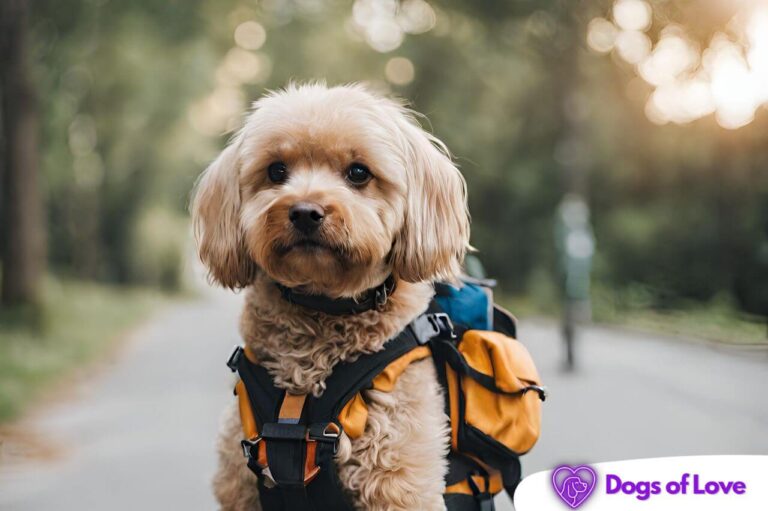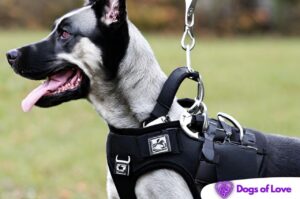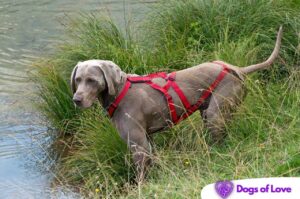Are you wondering when is the best time to get your furry best friend a backpack?
If you’re looking for an answer, then look no further!
Backpacking with our canine companions has become increasingly popular among outdoor adventurers.
Not only can it be beneficial for dogs and owners alike, but it can also give us insight into how well-prepared we are as pet parents.
This blog post will provide valuable information on the appropriate age for a dog to start wearing a backpack, what size they should wear based on their breed, and suggest other accessories that may be necessary while backpacking.
So, if you’ve been waiting to hit the trails with your pup in tow, keep reading and find out all there is to know about doggie backpacks!

What to Consider Before Letting Your Dog Wear a Backpack?
If you’re an active pet parent, you’ve probably considered letting your dog wear a backpack on your walks or hikes.
Before strapping on that extra load, there are a few things to remember.
First and foremost, the dog’s age. The dog must be at least two years old, and you should consider your pup’s size and build – not all dogs are built for carrying weight.
You’ll also want to start slow and build up gradually to avoid any strain or injury.
It’s essential to ensure the backpack fits properly and doesn’t shift around, as well as evenly distribute the weight on each side.
Lastly, consider the climate you’ll be in, and don’t overload the backpack with too much weight. The load should never exceed a reasonable proportion of your dog’s body weight (usually between 10% to 20% of their weight).
With these factors in mind, a backpack can be an excellent tool for active dogs and provide a sense of purpose and accomplishment.
What is the Dog’s Growth Cycle, and when can the dog start using a backpack?
The dog’s growth cycle encompasses the various stages of development from puppyhood to adulthood and into their senior years.
It begins with the energetic and impressionable puppy stage, characterized by rapid growth, exploration, and socialization.
As puppies transition into adolescence, their behaviors might shift as they seek independence while benefiting from consistent training and guidance.
The adult phase sees dogs reaching their full physical size and mental maturity and their personalities becoming more defined.
Eventually, they enter the senior stage, where they might experience changes in mobility and health.
When considering when a dog can start using a backpack, it’s essential to take their growth cycle into account.
Ideally, a dog’s growth plates, which are areas of developing cartilage in their bones, should be closed before they start carrying any significant weight.
This generally occurs around two years old, although more giant breeds may mature later. It’s crucial to consult with a veterinarian to determine the appropriate time for your specific dog to start using a backpack.
Even when they’re physically ready, it’s essential to introduce the backpack gradually and ensure it’s not overloaded, as excessive weight could strain their muscles and joints.
Monitoring their comfort, behavior, and overall well-being during and after wearing the backpack will help ensure a positive and safe experience.
Starting Slow with an Empty Backpack
When introducing a dog to wearing a backpack, it’s essential to start slow by initially having them wear an empty backpack.
This gradual approach allows the dog to become accustomed to the sensation of wearing the gear without the added weight.
Begin by letting your dog investigate the backpack and associate it with positive experiences, using treats and praise to create a positive association.
Place the empty backpack on your dog briefly while monitoring its comfort and behavior.
This step-by-step introduction helps them build confidence and reduces any potential anxiety.
Over time, gradually increase the duration of wear, ensuring the backpack fits properly and doesn’t cause any discomfort.
By beginning with an empty backpack, you lay the foundation for a successful and enjoyable experience when your dog is ready to carry items during outings.
Gradually Increase the Weight in the Pack
As your dog becomes accustomed to wearing an empty backpack, you can move on to the next step by gradually increasing the weight in the pack.
This process should be approached with caution and consideration for your dog’s age, size, breed, and physical condition.
Begin by adding a minimal amount of weight, such as a small water bottle, to the backpack.
Please pay close attention to your dog’s behavior, gait, and overall comfort as they wear the slightly heavier pack.
Over time, you can incrementally increase the weight, allowing your dog’s muscles and joints to adapt to the added load.
It’s crucial to avoid overburdening your dog; a general guideline is not to exceed 10-20% of their body weight.
Regularly assess their posture and behavior during walks, ensuring they’re not showing signs of strain or fatigue.
By taking a patient and gradual approach to increasing the weight in the pack, you prioritize your dog’s safety and well-being while enabling them to embrace their role as a pack-carrying companion comfortably.
Choosing the Right Pack for Your Dog’s Size and Shape
Selecting the appropriate backpack for your dog’s size and shape is a vital consideration when embarking on this venture.
Just as each dog is unique, so are their physical characteristics and comfort requirements.
When choosing a pack, opt for one designed for dogs, ensuring it’s adjustable to accommodate your dog’s proportions.
Consider your dog’s weight, chest circumference, and length to ensure a proper fit that doesn’t restrict movement or cause discomfort.
A pack that is too tight could lead to chafing or restricted breathing, while an ill-fitting one might slide around, causing uneven weight distribution.
Moreover, consider the pack’s design, including padding, ventilation, and attachment points, as these factors contribute to your dog’s overall comfort during wear.
By carefully selecting a backpack that suits your dog’s size and shape, you set the stage for a successful and enjoyable experience for you and your furry companion during your outdoor adventures.
In conclusion
Determining when a dog can start wearing a backpack requires a balanced approach, considering their growth cycle and physical development.
While each dog is unique, a general guideline is to wait until their growth plates have closed; this generally occurs around two years old, although more giant breeds may mature later.
Starting slowly with an empty backpack allows the dog to get accustomed to the sensation without the added weight, gradually building their confidence and comfort.
As they become more accustomed, you can introduce weight in the pack incrementally, keeping in mind not to exceed 10-20% of their body weight.
Selecting the right backpack that fits their size, shape, and movement is pivotal for their safety and comfort.
By adhering to these principles and consulting with a veterinarian, you ensure your dog’s well-being is a priority, creating a positive experience as they take on the role of a capable and content pack-wearing companion during your shared adventures.








